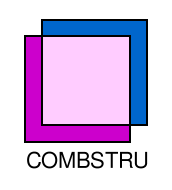
COMBSTRU
Combinatorial Structure of Intractable Problems

|
COMBSTRUCombinatorial Structure of Intractable Problems
Participating Institutions |
Integral part of our collective research experience is the European consortium DIMATIA, (Discrete Mathematics, Theoretical Informatics and Applications), which includes seven institutions involved in the project (Barcelona, Bielefeld, Bordeaux, Budapest, Pisa, Patras, and Prague), visit http://www.ms.mff.cuni.cz/acad/kam/dimatia. The center, formed in 1996 is generally viewed as the only European counterpart of DIMACS (Discrete Mathematics and Computer Science), a highly successful center which is in existence for more than 10 years, one of the national research centers in the US located at Rutgers university). DIMATIA organizes a variety of activities in all its partnership institutions including regular annual meetings, midsummer workshops, spring schools and both graduate for undergraduate students, and is a site of projected ERCIM working group on Theoretical Computer Science.
The continuation of the DIMATIA operation on the pan-European level is the core of this project. We believe that in the area described in the project Europe has strong competitive edge with is directed to future and young researches in boundary discipline of mathematics, computer science and applications.
The research teams of our project, while motivated by this broad activity, form a closely knit consortium, which is focused on the concrete goals of this proposal. We build a network of teams which mutually complement the advantages and existence of partners involved.
Our research teams have extensive experience in research and development related to the important issues towards completition of the goals in the project. On this complex level, there is no individual place in Europe and probably in the world where such a critical mass has been reached. Considering the goals to be achieved with this proposal, the size of the consortium is optimal.
As a general rule, all key scientific staff involved is committed to devote a 20% of their full employment time to the development of the project.
| Location | Institute | Leader |
| Barcelona | UPC | Josep Diaz <diaz@lsi.upc.es> Team webpage: http://maite71.upc.es/limda/ |
| Berlin | Freie Univ., Humbodlt Univ. and Tech. Univ. |
Helmut Alt <alt@inf.fu-berlin.de> |
| Bielefeld | Bielefeld University | Rudolph Ahlswede <ahlswede@mathematik.uni-bielefeld.de> |
| Bordeaux | LABRI, Univ. Bordeaux I | Andre Raspaud <raspaud@labri.fr> Team webpage: http://www.labri.fr/graphes/ |
| Budapest | Renyi Institute (Hungarian Academy of Sciences) |
Ervin Gyori <gyori@renyi.hu> |
| Oxford | Oxford University | Dominic Welsh <dwelsh@maths.ox.ac.uk> |
| Patras | CTI | Paul Spirakis <spirakis@cti.gr> |
| Pisa | CNR-IMC | Marco Pellegrini <marco.pellegrini@iit.cnr.it> Team webpage: http://www.iit.cnr.it |
| Prague | DIMATIA, Charles University | Jaroslav Nesetril <nesetril@kam.ms.mff.cuni.cz> |